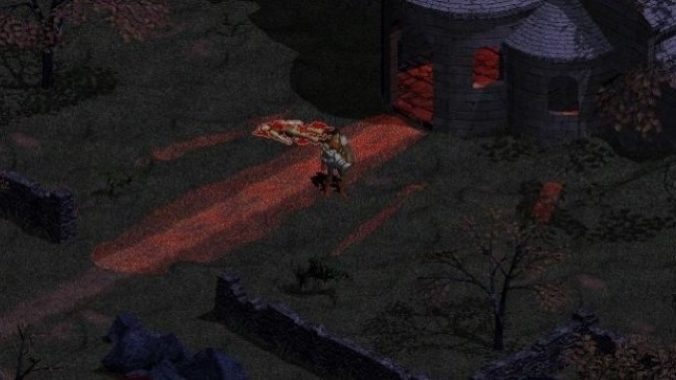
As a kid, I devoured Warcraft 3 and Starcraft on my parents’ Macintosh, playing them over and over again. Diablo was the only one of Blizzard’s franchises I never touched. It was rated M and it was called “devil.” Growing up Mormon, I was raised to believe that the wrong kind of game or movie could reach out and bite you. One kid brought his copy of Diablo 2 to a third grade show-in-tell and I felt certain this communicated something about his badness. The game was haunted and I didn’t want to be haunted too.
In the cold light of adulthood, Diablo seems pretty damn mundane, all told. I liked Blizzard games because they gestured at the science fiction and fantasy I was reading, watching, and failing to write. Very little truly original or strange thoughts or ideas are in Blizzard games, today or then, but the gestures can still feel like enough. I loved the sensation that I could make my own worlds here, that the tools of swords, orcs, and quests could construct my own visions.
Diablo is really no different, except that it is even smaller from a lore perspective. Its mythology of kings and curses, demons and angels is pretty familiar territory for dark fantasy. The characters that populate its little town of Tristram are all fantasy stereotypes of innocent barmaids, wise old men, and town drunkards. Diablo could even take place in some dark corner of the Warcraft map. Who could really tell?
Diablo‘s ambitions were large in some sense, but the product itself is pretty bare, at least by modern standards. At the beginning of the game you pick from just three classes, all with pre-made character designs. Its dungeon is lined with randomized tile-sets, different hallways layered with the same wall textures. Even within the first three layers of the dungeon, slightly stronger palette-swapped enemies begin to strike. You gain abilities slowly, so much of the early game is just clicking on enemies until they die.
All this might sound like complaining, but let me clarify: It rules. Videogames are very good at languishing in a mood or tone. Diablo‘s bareness lets you sink into it. I love Tristram’s eternal night, the red glow of cathedral windows, the chittering and chattering of countless undead and demons. I love the idea of endless descending, the landscape shifting around you, until it is all fire and brimstone. I love the mundanity of Diablo‘s heroes. You’re not a chosen hero or a leader of nations. You’re just some guy caught in an old village on the edge of the world, built over the mouth of hell.
I’m fascinated by the first entries in a series, the identities a work was allowed to have before it becomes twisted into Intellectual Property. Playing Diablo feels a bit like watching George Lucas’s debut film THX 1138. Before the density of lore, tie-in novels, and videogames that Star Wars would bring, THX is small budget, experimental, and strange. None of its mysteries have been explained away in extraneous material. It’s resistant to being solved. Diablo is not as striking as THX, and in hindsight its transformation into corporate IP seems inevitable, but every big project is a risk of one kind or another. Diablo‘s bare evocation is a result of both intentional design and paths not taken.
Diablo‘s original designers had ambitions for small Magic The Gathering-like expansion packs to be placed next to cash registers, according to the original pitch document. This format was abandoned in favor of a more traditional expansion. The irony is that Diablo IV, and its mobile sibling Diablo Immortal, are far closer to that original design in terms of business model, but further away in terms of scale. This contradiction is evident in the pitch document itself: “As games today substitute gameplay with multimedia extravaganzas, and strive toward needless scale and complexity, we seek to invigorate the hack and slash, feel good gaming audience.” Diablo was pitched at once as a game that could last forever and a return to the straightforward joys of the overstuffed medium.
Despite its bareness, its legacy is expressed in the franchise’s newest release. Diablo IV is truly a “multimedia extravaganza” advertised with a trailer directed by Oscar-winning Chloe Zhao, a social media campaign featuring Megan Fox, and a song performed by Halsey. Diablo, the original game, is just a legacy that the series can call back to. The sequel is clearly meant to supplant its forebears.
Diablo is not exactly in danger of being forgotten, but I do think it is in danger of being under-estimated. Games criticism is still abound with sentences like “the graphics were impressive for the time.” There is endless comparison with the future product that will improve the original or a remake that will replace it entirely. Diablo doesn’t need to be replaced; it could exist alone, outside of the franchise it spawned, and still be worth playing on its own merits. But as the franchise’s ambitions scaled up, the charming simplicity that was its strongest point was forgotten. In this way, I suppose, it is haunted. Not by demons or cursed kings, but by the endless scale that it once promised.
Grace Benfell is a queer woman, critic, and aspiring fan fiction author. She writes on her blog Grace in the Machine and can be found @grace_machine on Twitter.